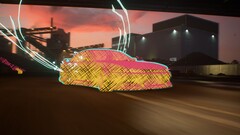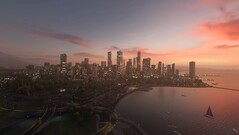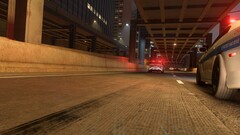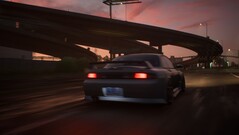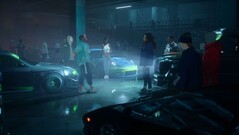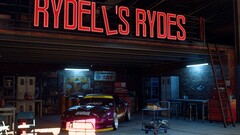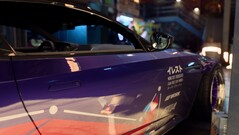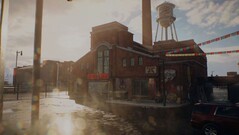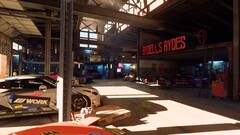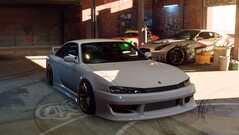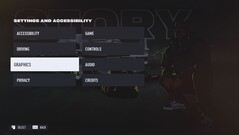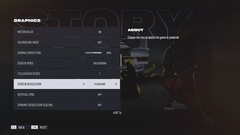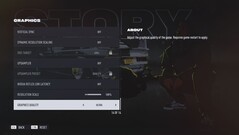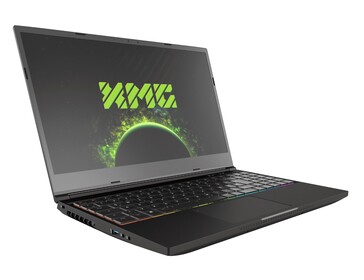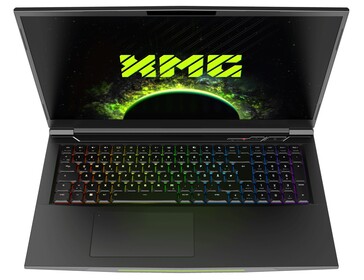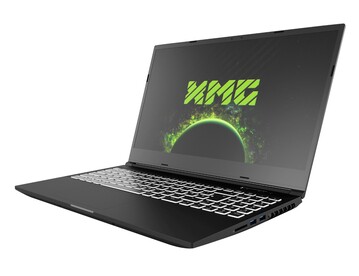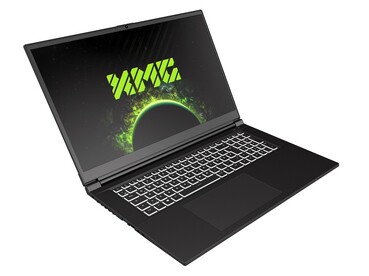Need for Speed Unbound review: notebook and desktop benchmarks
Technical aspects
NFS Unbound is developed by Criterion Games, a British game studio that already made three previous entries in the series: Hot Pursuit (2010), Most Wanted (2012) and Rivals (2013). Unlike most of the recent NFS games, Unbound is finally bringing a breath of fresh air to the series thanks to its comic-inspired aesthetic. The Frostbite Engine made by Battlefield developer DICE also ensures the game looks great.
Besides having high draw distance, the game also features impressive car models and many environmental textures. But Criterion can often go overboard with visual effects. Unbound's gameplay is likewise solid and reminds us of the good old Underground era with night races, car tuning and wild police chase sequences. Sure, you'll need a while to get used to how cars handle in the game (particularly drifting), but otherwise it is relatively easy to get the hang of Unbound if you can ignore the sometimes odd physics.
The presentation of the story (at least at the beginning) is surprisingly intense and doesn't appear to be as tacky, clichéd and awkward as some of the previous entries in the series. Furthermore, the inclusion of pedestrians makes the game world feel more realistic and atmospheric.
Other than the fairly limited options, there is hardly anything else to complain about the graphics menu. At the top, there are options for adjusting motion blur, gamma, screen mode and resolution. Further down, you'll find settings such as V-Sync, dynamic resolution scaling, upsampling (DLSS or FSR) and resolution scaling – all of which were disabled for the benchmarks. The menu also gives you four handy presets, but switching between them requires the game to be restarted. Too bad the game doesn't tell you this using a pop-up message but instead only mentions it in passing in the description.
Nevertheless, not everything that glitters is gold when it comes to Unbound's technical performance. Whilst testing the game on some systems, we encountered problems with the fullscreen mode (especially when changing resolution) as well as when launching the game (the required EA app sometimes refused to work properly). Another annoying issue is that many of our Nvidia-based laptops experienced abnormally poor performance when connected to an external monitor, despite having the latest driver (ForceWare 527.37). For this review, we tested out the Steam version of Unbound, which takes up roughly 30 GB of drive space – a fairly average file size for a modern game.
Benchmark
Because NFS Unbound doesn't come with a built-in benchmark tool, our measurements are based on a sequence created by us. After the player leaves the garage for the first time and reloads the game, it will the place the player at the fuel station shown in the video below. From the station, we then drove along a predetermined path for around 30 seconds and captured the performance using the tool CapFrameX. Due to the fast-paced nature of the game, we recommend hitting at least 40 fps or, even better, above 50-60 fps.
Results
We mainly used devices on loan from XMG (Schenker Technologies) for the benchmarks.
FHD (1,920 x 1,080)
Whilst Intel iGPUs failed to run the game properly even at 720p, some of the low-end chips from AMD and Nvidia were at least able to achieve reasonably smooth frame rates at 1080p. By contrast, those who have a mid-range GPU or above can expect a pretty good gaming experience at this resolution. For instance, the game will run fairly well on a GeForce RTX 3050 Ti even at high to max settings.
| Need for Speed Unbound | |
| 1920x1080 Low Preset 1920x1080 Medium Preset 1920x1080 High Preset 1920x1080 Ultra Preset | |
| NVIDIA GeForce RTX 3080, i9-12900K | |
| NVIDIA GeForce RTX 3070, i9-12900K | |
| NVIDIA GeForce RTX 3080 Ti Laptop GPU, i9-12900HX | |
| NVIDIA GeForce RTX 3080 Laptop GPU, i7-11800H | |
| NVIDIA GeForce RTX 3070 Laptop GPU, i7-11800H | |
| AMD Radeon RX 6800M, R9 5900HX | |
| NVIDIA GeForce RTX 3060 Laptop GPU, i7-11800H | |
| AMD Radeon RX 6600M, R7 5800H | |
| NVIDIA GeForce RTX 3050 Ti Laptop GPU, i7-11800H | |
| AMD Radeon 680M, R9 6900HS | |
| Intel Iris Xe Graphics G7 96EUs, i7-1165G7 | |
QHD (2,560 x 1,440)
To play the game at 1440p and Ultra preset, you should already be looking at a high-end graphics card, such as the Radeon RX 6800M.
| Need for Speed Unbound | |
| 2560x1440 Ultra Preset | |
| NVIDIA GeForce RTX 3080, i9-12900K | |
| NVIDIA GeForce RTX 3070, i9-12900K | |
| NVIDIA GeForce RTX 3080 Laptop GPU, i7-11800H | |
| NVIDIA GeForce RTX 3070 Laptop GPU, i7-11800H | |
| AMD Radeon RX 6800M, R9 5900HX | |
| AMD Radeon RX 6600M, R7 5800H | |
UHD (3,840 x 2,160)
At 4K resolution, there is really no way around a very high-end GPU if you want to max out the settings. NFS Unbound is pretty smooth and playable at 4K on a GeForce RTX 3070 or higher.
| Need for Speed Unbound | |
| 3840x2160 Ultra Preset | |
| NVIDIA GeForce RTX 3080, i9-12900K | |
| NVIDIA GeForce RTX 3070, i9-12900K | |
| AMD Radeon RX 6800M, R9 5900HX | |
| AMD Radeon RX 6600M, R7 5800H | |
Note
Because gaming tests are very time-consuming and are often constrained by installation or activation limits, we are only able to provide you with part of the benchmark results at the time of publishing this article. We will be adding more graphics cards over the coming days and weeks.
Overview
Test systems
| Device | Graphics card | Processor | RAM | Operating system |
|---|---|---|---|---|
| Notebooks | ||||
| MSI Titan GT77 12UHS | Nvidia GeForce RTX 3080 Ti @175 W TGP (16 GB GDDR6) | Intel Core i9-12900 | 2 x 16 GB DDR5 | Windows 11 |
| XMG Neo 15 | Nvidia GeForce RTX 3080 @165 W TGP (16 GB GDDR6) | Intel Core i7-11800H | 2 x 16 GB DDR4 | Windows 11 |
| XMG Neo 17 | Nvidia GeForce RTX 3070 @140 W TGP (8 GB GDDR6) | Intel Core i7-11800H | 2 x 16 GB DDR4 | Windows 11 |
| XMG Core 15 | Nvidia GeForce RTX 3060 @130 W TGP (6 GB GDDR6) | Intel Core i7-11800H | 2 x 16 GB DDR4 | Windows 11 |
| XMG Focus 17 | Nvidia GeForce RTX 3050 Ti @75 W TGP (4 GB GDDR6) | Intel Core i7-11800H | 2 x 16 GB DDR4 | Windows 11 |
| Asus ROG Strix G15 | AMD Radeon RX 6800M (12 GB GDDR6) | AMD Ryzen 9 5900HX | 2 x 8 GB DDR4 | Windows 11 |
| Lenovo Legion 5 | AMD Radeon RX 6600M (8 GB GDDR6) | AMD Ryzen 7 5800H | 2 x 8 GB DDR4 | Windows 11 |
| Asus ROG Zephyrus G14 | AMD Radeon 680M | AMD Ryzen 9 6900HS | 2 x 16 GB DDR5 | Windows 11 |
| Zotac ZBOX CI665 Nano | Intel Iris Xe Graphics G7 (96 EUs) | Intel Core i7-1165G7 | 2 x 8 GB DDR4 | Windows 11 |
| Tower PCs | ||||
| Custom I | MSI GeForce RTX 3080 (10 GB GDDR6X) MSI GeForce RTX 3070 (8 GB GDDR6) |
Intel Core i9-12900K | 2 x 16 GB DDR4 | Windows 11 |
| Custom II | Palit GeForce RTX 4090 GameRock OC (24 GB GDDR6X) Nvidia GeForce RTX 3090 FE (24 GB GDDR6X) Nvidia GeForce RTX 3060 Ti (8 GB GDDR6X) Nvidia Titan RTX (24 GB GDDR6) Nvidia GeForce RTX 2070 Super (8 GB GDDR6)Nvidia GeForce RTX 2060 Super (8 GB GDDR6) KFA2 GeForce GTX 1660 Super (6 GB GDDR6) PNY GeForce GTX 1660 (6 GB GDDR5) KFA2 GeForce GTX 1650 Super (4 GB GDDR6) AMD Radeon RX 6800 (16 GB DDR6) AMD Radeon RX 6700 XT (12 GB DDR6) AMD Radeon RX 6650 XT (8 GB GDDR6) AMD Radeon RX 6600 (8 GB GDDR6) AMD Radeon RX 5700 XT (8 GB GDDR6) AMD Radeon RX 5700 (8 GB GDDR6) AMD Radeon RX 5600 XT (6 GB GDDR6) AMD Radeon RX 5500 XT (8 GB GDDR6) |
AMD Ryzen 9 7950X | 2 x 16 GB DDR5 | Windows 11 |
| Custom III | Nvidia GeForce RTX 2080 Super FE | Intel Core i9-11900K | 2 x 8 GB DDR4 | Windows 11 |
| Mini-PCs | ||||
| Morefine S500+ | AMD Radeon RX Vega 8 | AMD Ryzen 9 5900HX | 2 x 16 GB DDR4 | Windows 11 |
| Minisforum NUCXi7+ | Nvidia GeForce RTX 3070 @125 W TGP (8 GB GDDR6) | Intel Core i7-11800H | 2 x 8 GB DDR4 | Windows 11 |
| Minisforum HX90G+ | AMD Radeon RX 6600M @100 W TGP (8 GB GDDR6) | AMD Ryzen 9 5900HX | 2 x 16 GB DDR4 | Windows 11 |
| 4K Monitors | Nvidia driver | AMD driver |
|---|---|---|
| Asus PB287Q, Philips Brilliance 329P9H, Acer Predator XB321HK | ForceWare 527.37 | Adrenalin 22.12.2 |






